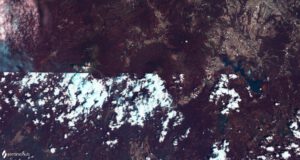 INSIVUMEH volcanologists describe the explosive activity on the Fuego as moderate to strong. Between 12 and 16 Vulcanian eruptions are generated per hour. They cause volcanic ash to rise to a height of 4900 m above sea level. The ash clouds drift westward and cover distances of up to 15 km. Glowing tephra is ejected several hundred meters above crater height. Glowing debris avalanches are created which flow off through the various drainage channels. On a 2 day old satellite photo you can still see a lava flow flowing south. In the current Bulletin there is no more talk about it.
INSIVUMEH volcanologists describe the explosive activity on the Fuego as moderate to strong. Between 12 and 16 Vulcanian eruptions are generated per hour. They cause volcanic ash to rise to a height of 4900 m above sea level. The ash clouds drift westward and cover distances of up to 15 km. Glowing tephra is ejected several hundred meters above crater height. Glowing debris avalanches are created which flow off through the various drainage channels. On a 2 day old satellite photo you can still see a lava flow flowing south. In the current Bulletin there is no more talk about it.
 Marc Szeglat
Marc Szeglat
Ol Doinyo Lengai with heat signature
 The volcano in the East African Rift Valley is still active. This is confirmed by a heat signature captured by MIROVA and Sentinel. Mirova indicates a thermal radiation of 6 MW. Sentinel images in the infrared spectrum show 2 thermal anomalies. One emanates from the central crater area where a large hornito recently grew. Another hotspot formed on the southwestern crater rim. If you look closer at the photo you can see black lava flows flowing along the crater rim and flowing into the central area. Layer by layer the pit crater is filling up again and with a little luck it could be accessible again in a few years.
The volcano in the East African Rift Valley is still active. This is confirmed by a heat signature captured by MIROVA and Sentinel. Mirova indicates a thermal radiation of 6 MW. Sentinel images in the infrared spectrum show 2 thermal anomalies. One emanates from the central crater area where a large hornito recently grew. Another hotspot formed on the southwestern crater rim. If you look closer at the photo you can see black lava flows flowing along the crater rim and flowing into the central area. Layer by layer the pit crater is filling up again and with a little luck it could be accessible again in a few years.
The only question then is how we will travel to and in Africa? Thanks to the Corona Pandemic, we are probably at a turning point. The airlines are mothballing more and more planes and laying off staff on a grand scale. Even if the pandemic becomes manageable thanks to vaccination, it will be years before we are even close to pre-pandemic levels of travel technology.
Etna: Northeast-Crater is active
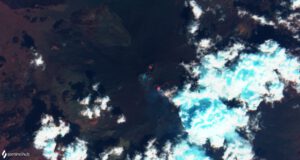 Etna in Sicily erupts from 2 of its summit craters. Besides the known strombolian eruptions from the saddle vent of the New South East Crater, weak eruptions in the Northeast Crater have now been confirmed. A thermal anomaly in NE crater had been visible on sentinel satellite photos for some time. Now the mountain guide Gio Giusa climbed the crater and documented weak eruptions. They come from one of 3 small hornitos rising from the deep crater floor. Activity in the Northeast Crater was recently an indicator of a general increase in Etna’s activity. From here the activity often shifted to the central crater. This is currently quite quiet.
Etna in Sicily erupts from 2 of its summit craters. Besides the known strombolian eruptions from the saddle vent of the New South East Crater, weak eruptions in the Northeast Crater have now been confirmed. A thermal anomaly in NE crater had been visible on sentinel satellite photos for some time. Now the mountain guide Gio Giusa climbed the crater and documented weak eruptions. They come from one of 3 small hornitos rising from the deep crater floor. Activity in the Northeast Crater was recently an indicator of a general increase in Etna’s activity. From here the activity often shifted to the central crater. This is currently quite quiet.
Sangay with strong eruption
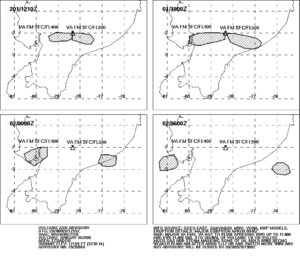 Yesterday the sangay erupted very strongly. The eruption was explosive in nature and transported volcanic ash to an altitude of 50,000 feet, which is 15,240 meters above sea level. The VAAC reported the ash cloud at 12:59 UCT. In Ecuador it was 7:59 a.m. More explosions followed during the day, in which the explosions lost some of their force but still carried ash at more than 10,000 meters above sea level. At different altitudes, the air currents blew in different directions: The lower part of the eruption cloud was transported westward, the upper part eastward. This circumstance caused ash rain in 6 of the 24 provinces of the country. The regional airport of Guayaquil temporarily stopped its operations because the ash endangered air traffic. The country’s government promised to help the cattle ranchers to remove the ashes. It covers the pastures and contaminates the drinking water, not only for the cattle.
Yesterday the sangay erupted very strongly. The eruption was explosive in nature and transported volcanic ash to an altitude of 50,000 feet, which is 15,240 meters above sea level. The VAAC reported the ash cloud at 12:59 UCT. In Ecuador it was 7:59 a.m. More explosions followed during the day, in which the explosions lost some of their force but still carried ash at more than 10,000 meters above sea level. At different altitudes, the air currents blew in different directions: The lower part of the eruption cloud was transported westward, the upper part eastward. This circumstance caused ash rain in 6 of the 24 provinces of the country. The regional airport of Guayaquil temporarily stopped its operations because the ash endangered air traffic. The country’s government promised to help the cattle ranchers to remove the ashes. It covers the pastures and contaminates the drinking water, not only for the cattle.
Los Angeles: Earthquake Mw 4,5
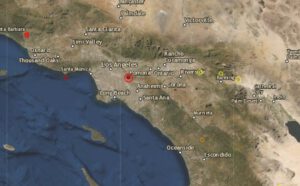 Yesterday morning, an earth tremor with a magnitude of 4.5 shook the greater Los Angeles area. The epicenter was 8 km east of Los Angeles. The depth of the epicenter was indicated by USGS as 18 km. According to the EMSC, the hypocenter was located at a depth of 20 km. In spite of the comparatively large depth of the focus, the earthquake was clearly perceived in the Los Angeles area. There are reports of small damages like cracks in house walls. Larger damages did not occur.
Yesterday morning, an earth tremor with a magnitude of 4.5 shook the greater Los Angeles area. The epicenter was 8 km east of Los Angeles. The depth of the epicenter was indicated by USGS as 18 km. According to the EMSC, the hypocenter was located at a depth of 20 km. In spite of the comparatively large depth of the focus, the earthquake was clearly perceived in the Los Angeles area. There are reports of small damages like cracks in house walls. Larger damages did not occur.
The earthquake manifested itself in the same fault zone as the 1987 Whittier Narrows earthquake, which had a magnitude of 5.9 and caused destruction in the city. The activated fault zone is the Puente Hills thrust fault, which is associated with the San Andreas Rift.
Translated with www.DeepL.com/Translator (free version)
Sangay with further volcanic eruptions
 The Ecuadorian volcano Sangay keeps the local press busy, as it continues to be active and once ventured out of its cloud cover. On pictures you can see that on the southern flank of the volcano a deep channel has been created, through which lava flows and pyroclastic flows flow. In addition, the sangay is explosively active and promotes volcanic ash. The VAAC registered it today at an altitude of 6000 m. The ash drifts in a westerly direction. Media reports say that ash clouds have risen up to 870 m above crater height. Lahars now pose a permanent threat and influence the hydrology of the river landscape at the foot of the mighty volcano. Sangay is located at the edge of the Amazon basin, in one of the wettest regions on earth.
The Ecuadorian volcano Sangay keeps the local press busy, as it continues to be active and once ventured out of its cloud cover. On pictures you can see that on the southern flank of the volcano a deep channel has been created, through which lava flows and pyroclastic flows flow. In addition, the sangay is explosively active and promotes volcanic ash. The VAAC registered it today at an altitude of 6000 m. The ash drifts in a westerly direction. Media reports say that ash clouds have risen up to 870 m above crater height. Lahars now pose a permanent threat and influence the hydrology of the river landscape at the foot of the mighty volcano. Sangay is located at the edge of the Amazon basin, in one of the wettest regions on earth.
Pacaya erupts lava flows on 17.09.20
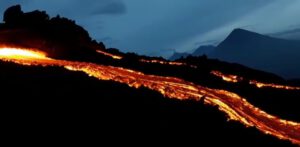 The Guatemalan volcano Pacaya is still active today and erupts at least one lava flow, which flows over the southern flank of the volcano and has a length of 400 m. MIROVA registers a high thermal radiation with 234 MW power, which confirms the lava flow. The photo should show this lava flow. The exact date of the photo is not known. On the screenshot you can see not only the lava flowing out of a tunnel in the lower part of the McKenney cone, but also the volcanoes Agua and Fuego in the background. Speaking of McKenney crater. This one erupts strombolian. According to reports from INSIVUMEH, the ejection height of glowing tephra is up to 100 m.
The Guatemalan volcano Pacaya is still active today and erupts at least one lava flow, which flows over the southern flank of the volcano and has a length of 400 m. MIROVA registers a high thermal radiation with 234 MW power, which confirms the lava flow. The photo should show this lava flow. The exact date of the photo is not known. On the screenshot you can see not only the lava flowing out of a tunnel in the lower part of the McKenney cone, but also the volcanoes Agua and Fuego in the background. Speaking of McKenney crater. This one erupts strombolian. According to reports from INSIVUMEH, the ejection height of glowing tephra is up to 100 m.
Fuego with double strike
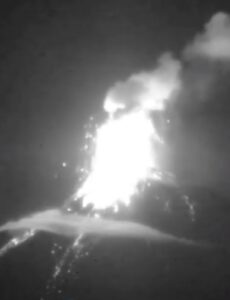 The Fuego in Guatemela never gets tired of spewing lava. Yesterday a rare double impact was recorded when 2 strombolian eruptions occurred directly after each other. Glowing tephra was ejected several hundred meters high. The lumps landed on the volcano flank and went down as debris avalanches.
The Fuego in Guatemela never gets tired of spewing lava. Yesterday a rare double impact was recorded when 2 strombolian eruptions occurred directly after each other. Glowing tephra was ejected several hundred meters high. The lumps landed on the volcano flank and went down as debris avalanches.
INSIVUMEH reports 8-11 explosive eruptions per hour. The tephra rises up to 300 m above crater level. Volcanic ash makes it to 4700 m above sea level. The volcano continues to be effusive and erupts a lava flow. It flows through the erosion gully of Ceniza and is a good 100 m long. The warning of lahars remains because of the heavy rainfall. For the same reason our LiveCam has failed again. Despite water-protected technology it always finds a way to paralyze the cam. Ulli is trying to get the camera back online as soon as possible.
Grimsvötn: Earthquake M 3.3
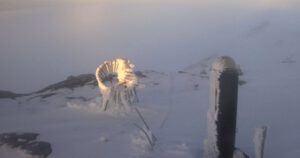 Tonight there was an earth tremor of magnitude 3.3 near Grimsvötn volcano. The epicenter was 11.1 km east of Hamarinn. The center of the earthquake was with 3.8 km relatively flat. Hamarinn is a subglacial volcano located in the west of the Icelandic glacier Vatnajökull and belongs to a system of crevasses that connects Grimsvötn and Bardarbunga. There have been 3 other weak earthquakes along the volcanic system.
Tonight there was an earth tremor of magnitude 3.3 near Grimsvötn volcano. The epicenter was 11.1 km east of Hamarinn. The center of the earthquake was with 3.8 km relatively flat. Hamarinn is a subglacial volcano located in the west of the Icelandic glacier Vatnajökull and belongs to a system of crevasses that connects Grimsvötn and Bardarbunga. There have been 3 other weak earthquakes along the volcanic system.
Since a few weeks an increase of seismic activity at Grimsvötn can be observed. Volcanic experts assume that the volcano is preparing for an eruption. Whether and when a volcanic eruption will occur cannot be predicted yet.
Fuego increases activity in September
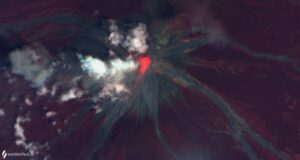 The Fuego in Guatemala has further increased its effusive and explosive activity. INSIVUMEH reports an increase in activity that began on September 5. However, there are significant variations in the intensity of activity. For example, a lava flow flows in the channel of Cenzia, whose length fluctuates between 100 and 650 m. On a recent sentinel satellite photo in the infrared range, the lava flow can be clearly seen. Hot avalanches are ejected from the lava front. Additionally, explosive eruptions occur. The VAAC Darwin issued 2 Vona warnings today, after which volcanic ash was detected at an altitude of 4600 m. Glowing tephra is ejected several hundred meters high and triggers debris avalanches on the flank. On the seismograms one can see numerous vibrations. Sometimes the explosions generate seismic signals with large peak amplitudes. Unfortunately, it is precisely during this phase of increased activity that our LiveCam failed. Our man on site is trying to get it back online quickly.
The Fuego in Guatemala has further increased its effusive and explosive activity. INSIVUMEH reports an increase in activity that began on September 5. However, there are significant variations in the intensity of activity. For example, a lava flow flows in the channel of Cenzia, whose length fluctuates between 100 and 650 m. On a recent sentinel satellite photo in the infrared range, the lava flow can be clearly seen. Hot avalanches are ejected from the lava front. Additionally, explosive eruptions occur. The VAAC Darwin issued 2 Vona warnings today, after which volcanic ash was detected at an altitude of 4600 m. Glowing tephra is ejected several hundred meters high and triggers debris avalanches on the flank. On the seismograms one can see numerous vibrations. Sometimes the explosions generate seismic signals with large peak amplitudes. Unfortunately, it is precisely during this phase of increased activity that our LiveCam failed. Our man on site is trying to get it back online quickly.